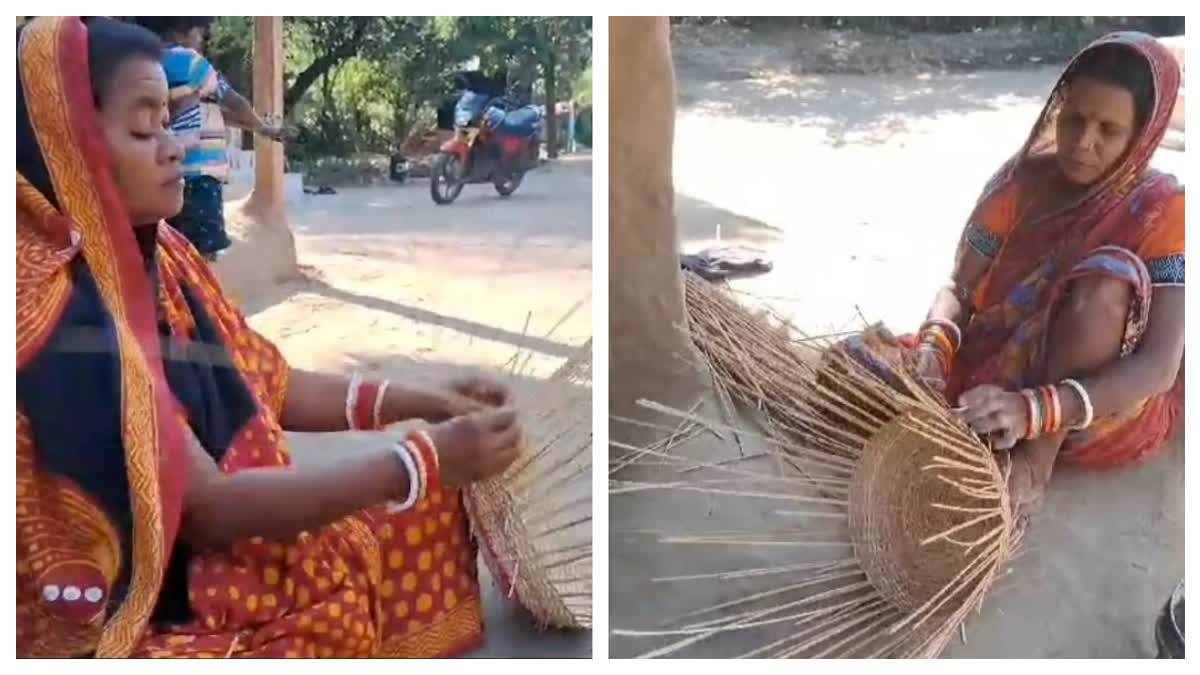Odisha's Naliya Weaving On Verge Of Extinction As Plastic And Forest Bans Crush Artisan Livelihoods

8/30/2025, 10:41:01 AM
Kendrapara: Bhitargarh has changed. Once reverberating with the sounds of grass whistle from dawn till dusk, the village located on the fringes of the Bhitarkanika mangroves, has, with time, fallen silent. Once, families used to sit together, slicing and drying reeds of wild grass called Naliya, weaving them into ropes, sturdy baskets, mats, and daily-use items. But the craft is almost on the verge of extinction amid the rising market of plastic and years of neglect. For more than a hundred years, people of Bhitargarh mostly from the Jena community, depended on Naliya products to earn a livelihood. The grass grows mostly at the meeting point of fresh and salt water, explaining the dependence of the villagers located in the periphery. "Generations have survived by weaving Naliya and we too grew up with the reeds. But look at these products now. No one wants these things when plastic has swept the market for the last many years," says Apuri Jena, while braiding strands into a small basket. Nearly 250 men and women from about 30 families engaged in making household items like pachhia (winnowing fans), dala (baskets), asanas (mats), mugura (stools), and jhamp (large containers) to sustain their families. The process begins with collection of the grass which is then softened being dipped in water. Some time later, those are brought out, dried and cut into strips. It is through the strips that weaving is done. The artisans, at times, dye the strands bright red or green to make the products more colourful. "The entire process is cumbersome and involves hard work. We sit from morning till evening, twisting and tying the grass strips. Earlier, even if we made one or two big baskets, we were able to sell them in the weekly market and earn. Now, even though we weave five baskets, nobody looks at them. People choose plastic which is durable and less pricey," says Rina Jena, a weaver. But the artisans' struggle does not end with market demand. In fact it begins with collecting Naliya grass. The reeds grow abundantly inside Bhitarkanika National Park and adjoining mangrove forests but due to rising crocodile population, the Forest Department has imposed restrictions on venturing into the forests. "Earlier we were taking canoes into Balrampur and Bansgarh to bring bundles of Naliya. Now, the foresters have set up barricades marking the areas as dangerous. We can trespass but there is always the fear of crocodiles. And if we do not get the main raw material Naliya, how can we weave?," reflects Bhimsen Jena, a middle-aged artisan. For the fear of the crocodiles, many families have stopped going into the forest altogether. Some of these craftsmen migrated for daily-wage work, while others are doing small vending jobs. Those who keep crafting earn something between Rs 200-Rs 300 after days of labour. Once full of dried reeds, the courtyards are now empty. "When we made a jhamp or dala, it was sold in a day because traders fetched products from our homes. Now even if take our baskets to the market, none buys. So sustenance through this craft from now on is under cloud. Most youths are leaving village to earn livelihood elsewhere," says Apuri. Rina agrees. "Plastic industry killed us. When plastic buckets cost Rs 150 and lasts years, why would anyone pay Rs 300 for our basket that lasts only one year and is vulnerable to weather vagaries?" she questions. But the artisans unanimously complained about the lack of recognition and support from the government. "We are 30 houses in this village, all dependent on Naliya. But the government has never tried to provide us support or help. No subsidy, neither are there marketing opportunities outside," regrets Bhimsen. Local officials acknowledge the crisis. Santosh Mohanty, Deputy Director of Handicrafts in Kendrapara, says, "Naliya is a wild grass that grows only in fertile coastal areas. It is abundantly available inside Bhitarkanika, but there are forest restrictions in place. Artisans cannot collect it freely as they used to earlier. We are already in talks for introducing Naliya cultivation outside the park area with NGO support, so that raw material can be made available legally to the craftsmen." But for the artisans, these promises are annually made to pacify their angst. "We hear every year that something will be done. But nothing changes," sighs Rina. For now, the future of Naliya weaving does not look bright though there are families who continue the craft amid hardships. "God gave us these reeds and we earned our livelihood. Now we cannot even practise the craft," says Apuri with a heavy heart. Locals believe, unless urgent steps are taken, market support, fair prices, and safe access to raw material are looked into, the craft may vanish. "Now that our children are not interested to carry forward the legacy, this art will die with us," says Bhimsen.